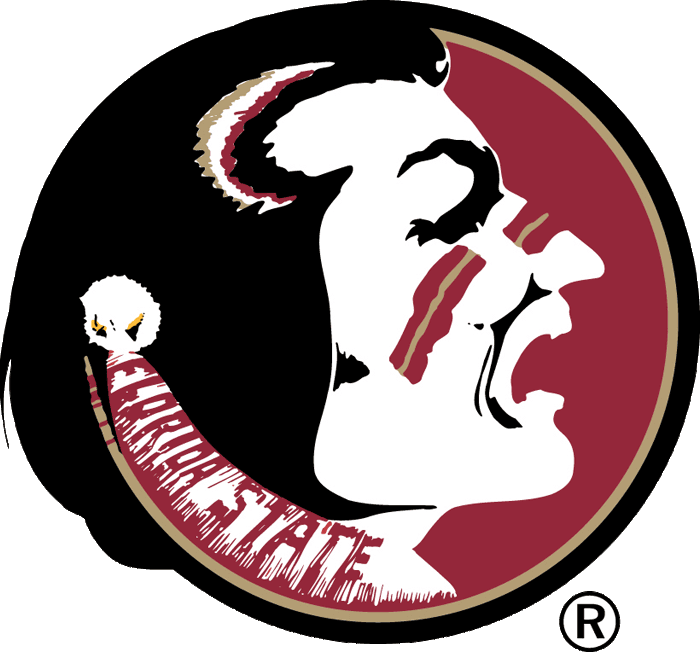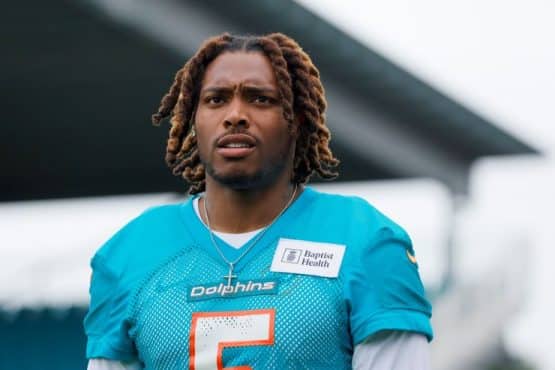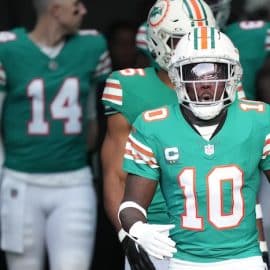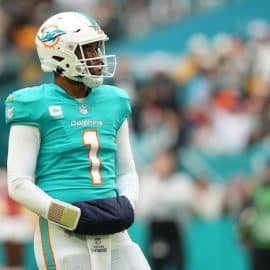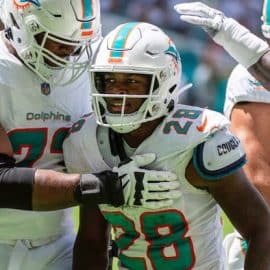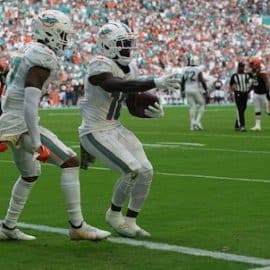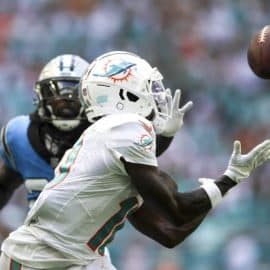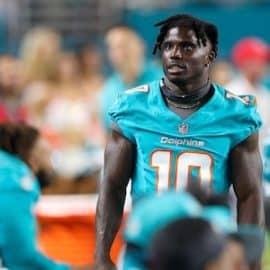Perhaps no one player on the Miami Dolphins has been more scrutinized this season than Ryan Tannehill. After so many years and so many quarterbacks since one Daniel Constantine Marino, Jr., the typical Dolphins fan naturally wonders if Ryan Tannehill is THE next Dolphins franchise quarterback. As this final regular season game against the New York Jets approaches, a game with significant playoff implications, arguably the biggest game that Ryan Tannehill has ever played in, the question remains, has he improved from 2012 to 2013? Let’s take a look at the numbers.
Inside the numbers
The most macroscopic way to look at the numbers is through the traditional QB statistics: Yards, TD’s, INT’s, Sacks, Completion percentage, and passer rating.
|
Source: NFL.com |
Yards |
TD |
INT |
Sacks |
Comp. % |
Passer RTG |
|
2012 |
3294 |
12 |
13 |
35 |
58.3 |
76.1 |
|
2013 (15 games) |
3709 |
23 |
14 |
58 |
61.1 |
84.6 |
On first glance, a few noticeable changes stick out. The yards and the touchdowns are way up; the touchdowns have nearly doubled and a good game vs the Jets gets him past the 4000 yards passing milestone. There is a slight uptick in the interceptions and large increase in the number of sacks; a number undoubtedly influenced by the much maligned 2013 offensive line. The completion percentage appears somewhat improved. Overall this suggests, as demonstrated by the higher passer rating, an at least somewhat improved quarterback.
A Deeper Dive
However, digging a little bit deeper muddies these, possibly premature, conclusions. Taking a temporary detour, for context, one can easily see that the Dolphins offense has been more unbalanced and pass heavy in 2013 as compared to 2012.
|
Source: NFL.com |
Passing Yds (% of total) |
Rushing Yds |
Total Yds |
Passing Tds (% of total) |
Rushing Tds |
Total TDs |
|
2012 |
3182 (63.8%) |
1802 (36.2%) |
4984 |
13 (46.4%) |
15 (53.6%) |
28 |
|
2013 (15 games) |
3363 (71.4%) |
1348 (28.6%) |
4711 |
23 (74.2%) |
8 (25.8%) |
31 |
A Ryan Tannehill cynic might astutely look at this shift in balance and state, “his touchdowns and yardage are up because his volume is up. If the team has replaced the run game with the pass game and he throws the ball more, the touchdowns and yards will commensurately increase.” Indeed, a look at Tannehill’s passes attempted and average yards per attempt only serves to support this explanation; in fact, the yards per attempt are nearly unchanged.
|
Source PFF (via subscription) |
Attempts |
Yds/Attempt |
|
2012 |
484 |
6.81 |
|
2013 (15 games) |
548 |
6.77 |
When touchdowns and interceptions are normalized to the number of passes attempted, while showing some improvement, these changes appear less drastic as well.
|
|
TDs per Attempt |
Ints per Attempt |
|
2012 |
2.5% |
2.7% |
|
2013 (15 games) |
4.2% |
2.6% |
An Even Deeper Dive
Taking this analysis one step deeper, thanks to the fine folks at www.ProFootballFocus.com (subscription only), one can look at Tannehill’s passing yardage by pass distance. This is broken into 3 categories, passes thrown between: 0-9 yds, 10-19 yds, and 20+ yds. Of note, a 4th category, passes thrown behind the line of scrimmage, has been excluded from this analysis. A comparison of 2012 to 2013 yields an even more intricate picture that at least hints at some of the drivers behind the bigger numbers.
|
2012 Season (source: adjusted PFF stats) |
0-9 yds |
10-19 yds |
20+ yds |
|
Yards (% of total) |
47.0% |
31.1% |
21.9% |
|
TDs |
6 |
3 |
3 |
|
INTs |
6 |
6 |
1 |
|
2013 Season (source: adjusted PFF stats) |
0-9 yds |
10-19 yds |
20+ yds |
|
Yards (% of total) |
45.7% |
37.9% |
16.4% |
|
TDs |
11 |
6 |
3 |
|
INTs |
3 |
5 |
6 |
The obvious change shown here is that the TD’s generated by passes between 0-9 yds have nearly doubled while the INT’s have been cut in half. Intriguingly, two other phenomena appear to be on display. There is a higher proportion of passes going to the 10-19 yd zone with a doubling of the touchdowns and one less interception as compared to 2012. PFF supports this improvement in the intermediate pass with a higher PFF QBR for intermediate passes (not shown) when 2013 is compared of 2012. In contrast to this positive, the deep passes, those 20 yards and longer, look to have worsened. Not only is the raw yardage less – 560 yards in 2013 vs 671 yards in 2012 – but the INT’s on the deep ball have increased from 1 all the way to 6. PFF supports this decrement in the deep pass game as well with a lower PFF QBR for deep passes (not shown) when 2013 is compared to 2012.
To summarize these findings, Tannehill appears to be throwing roughly the same proportion of short passes, but has increased his productivity within this zone with more TD’s and less INT’s. The intermediate passing game, too, appears improved with an increase in the proportion of passing yardage and touchdowns while the interceptions have been held in check. The deep pass game has disappointingly decreased as a proportion of the total yardage and the interceptions have risen dramatically from 1 to 6.
As an aside, it should be mentioned that Mike Wallace, per PFF, is tied for the 4th highest number of dropped passes for the 2013 NFL season amongst WR’s with 11 so far. This has contributed to making Ryan Tannehill the QB with the 3rd most passing yards lost to drops behind Stafford and Brady and to the underwhelming deep ball statistics.
The Intangibles and the Caveats
Statistics have often been noted to merely approximate one part of the truth. They can only tell a certain aspect of the story and reality is mostly made up of more complexity than any metric or group of metrics can adequately describe. This thin slice of statistical analysis surely is not exempt from such limitations.
There are many other metrics by which Ryan Tannehill’s performance could be dissected. What about 4th quarter comebacks? What about game-winning drives? What about passing under pressure? The list goes on and on and by no means should this fairly simplistic approach should be taken too seriously.
A Dolphins fan would have to be living in a hole during the last year to not know of just a few of the back stories and trends that could easily affect a young quarterback’s performance. These include BullyGate and the subsequent dissolution of the offensive line, and a newly acquired Mike Wallace with whom QB/WR chemistry was initially slow to develop. How can you measure these intangibles when looking at QB metrics? In short, it’s really hard and not possible to do so in a robust manner. It is almost miraculous that Ryan Tannehill will be starting his 16th straight game in this final week of the season after having been sacked an astounding 58 times (let alone the numbers he has put up in doing so). No metric can adequately capture that toughness. What about some other intangibles like the leadership he showed when standing up in front of the media circus as BullyGate unfolded? No metric can adequately capture that moment of leadership.
When these intangibles are considered, it is no surprise that many would look at any statistical analysis and reply simplistically, “I don’t care what you show me, he’s passed the eye test for me, he’s improved.”
Tomorrow's big game
Although football outcomes can never and should never be boiled down to one player, the ramifications that Ryan Tannehill’s performance in this final regular season game will have on his early reputation and expectations cannot be ignored. A win against a bitter Jets rival, on this biggest stage of his young career, will go a long ways to putting many an argument, statistical or not, to rest. It’s a team game, but a crucial win to cement a winning season and a likely playoff berth, and many of us will once again start to think that maybe this kid really might be THE next Miami Dolphins franchise quarterback.
Add The Sports Daily to your Google News Feed!
